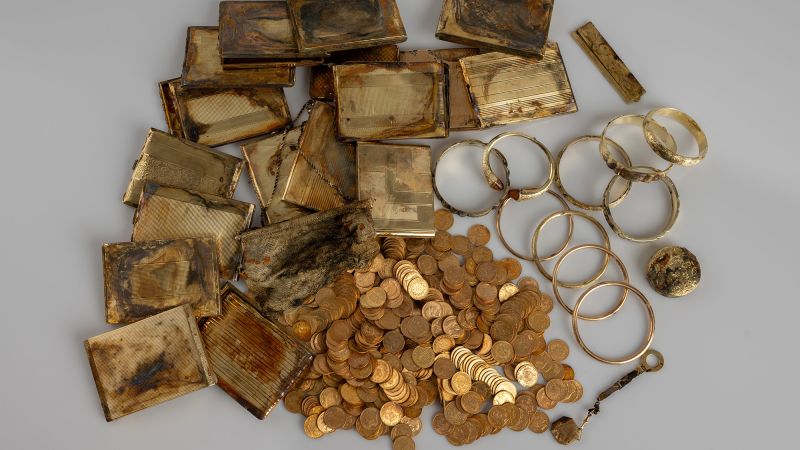In a remarkable discovery that has captivated both locals and historians alike, two hikers stumbled upon a treasure trove while navigating through the picturesque Krkonoše Mountains in the northeastern Czech Republic. This unexpected find includes a staggering assortment of items: ten gold bracelets, 17 cigar cases, a powder compact, a comb, and an incredible 598 gold coins. But the more fascinating aspect lies in the circumstances of its discovery and the historical implications surrounding the cache.
The hikers, whose identities have been deliberately kept private, were on a shortcut trail when their eyes caught sight of an aluminum box protruding from a stony wall. Their curiosity took over, and upon investigating, they uncovered the remarkable archive of historical valuables. A sense of responsibility drove them to bring the items directly to the Museum of Eastern Bohemia in Hradec Králové. Miroslav Novak, the head of the museum’s archaeological department, recounted how the finders approached without any prior notice, which marked the beginning of an intriguing exploration of the site.
Examination of the treasure revealed it to be relatively recent in historical terms, with one coin dated back to 1921. This time frame has raised stimulating discussions among archaeologists and historians. The potential theories regarding the treasure’s origin are rich and multifaceted. Speculations suggest that it may have belonged to individuals fleeing the tumultuous political climate leading up to World War II or during the aftermath, particularly around 1945 when the German populace was exiting the region. The possibility of war-related contexts surrounding this treasure makes it a vivid reminder of a period embroiled in upheaval.
During the ongoing analysis of the find, it has been established that the metal content from the gold coins alone weighs approximately 3.7 kilograms, valued at 8 million Czech koruna (around $360,000). This information generated considerable excitement within the local community, prompting the museum to receive intriguing anecdotal claims and local folklore, which may eventually help unlock the mysteries surrounding the treasure’s provenance.
Interestingly enough, the coins contain no local varieties, with half being of Balkan origin and the other half from France. The absence of Central European coins, particularly German ones, intrigues experts, especially in light of the historical ethnic borders in this region. The cache has sparked numerous hypotheses about who might have hidden the treasure, with local legends suggesting ties to affluent families, like the Swéerts-Špork family, known to have resided in the vicinity.
While findings of this nature are not commonplace in the region, Novak noted a past discovery of around 2,700 silver denarii, a type of medieval trade coin, found about nine kilometers southeast a decade ago. Such findings, accompanied by narratives of abandoned farms and subsequent population migrations during the 20th century, paint a picture of a landscape rich in historical nuances.
Vojtěch Brádle, the museum’s coin expert, remarks upon the unusual composition of the treasure. Typically, such finds from the 20th century showcase German and Czechoslovak coins, yet this batch deviates significantly, leading experts to postulate that most of the coins likely originated from the Balkan Peninsula, thus illustrating the complexities of trade and travel in the early decades of the century.
Delving deeper into historical context, Professor Mary Heimann from the University of Cardiff highlighted that 1921 marked not just the end of the Soviet-Polish War, but a period of significant economic instability in Czechoslovakia. This backdrop of crisis may provide insight into why someone would hastily conceal a stash of gold.
The narrative then leads us into murkier waters when considering the identities of those who might have hidden the treasure. The individual could be a collector, an employee from a museum, or someone entangled in the complexities of border-related tensions during the post-World War I era. The intertwined interests of cultural heritage and personal survival weave a tale that transcends mere monetary value.
As the museum prepares to preserve and exhibit this remarkable find, Czech law stipulates that such archaeological discoveries become property of the local regional administration at the moment of finding. A reward for the discoverers is contingent upon the assessed value of the metal. With a slated exhibition in the fall, the public’s anticipation mounts as they await further insights into this extraordinary newfound treasure, a relic echoing stories of its time, and showcasing the fascinating intersection of human history in the Czech lands.



